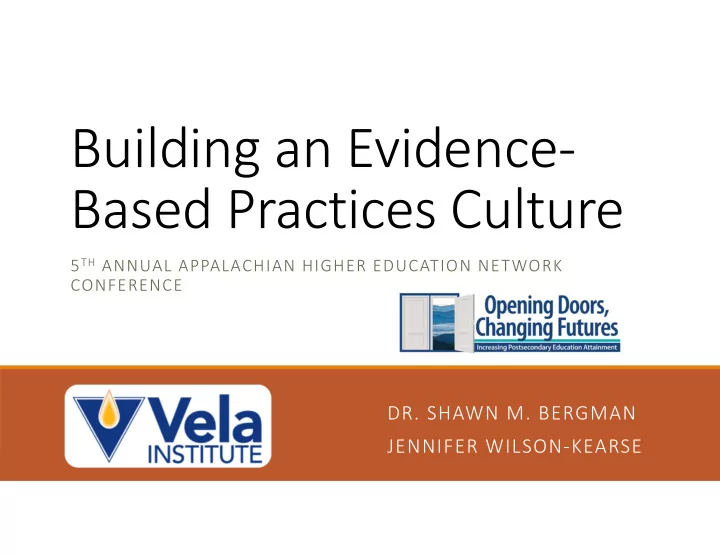

Building an Evidence‐ Based Practices Culture 5 TH ANNUAL APPALACHIAN HIGHER EDUCATION NETWORK CONFERENCE DR. SHAWN M. BERGMAN JENNIFER WILSON‐KEARSE
Who are these people?
Evidence‐based decision‐making Barends, E., Rousseau, D.M., & Brinner, R.B. (2014). Evidence‐based management: The basic principles. Amsterdam: Center for Evidenced‐Based Management.
How did we get here? 1990’s 1970’s 1980’s 2000’s 2010’s School‐based School Measurement No Child Left Data‐Driven Strategic Improvement Driven Behind Decisions Planning Planning Instruction https://www.rand.org/content/dam/rand/pubs/occasional_papers/2006/RAND_OP170.pdf
Data‐driven decisions: Where are we now?
Ignoring the evidence: Even the scientists
No regard for science: Hollywood too?
Data and evidence‐based decisions: The cycle and the culture Culture Measure Analyze Report Act
Data and evidence‐based decisions: The cycle and the culture Culture Measure Analyze Report Act DAM! DAM! DAM!
3 2 Analytics & Next Steps Education Do’s & Finding the Right Mix Working Together Don’ts 1 Data‐Driven Cultures Discussion overview
Analytics: What is it? Scientific process transforming data into insights to better decisions ◦ Discover ◦ Visualize ◦ Communicate Institute for Operations Research and the Management Sciences (2014)
Four Analytic Applications Prescriptive Analytics How to prevent bad things Future from happening and ensure good things? Predictive Analytics What is going to happen? Retrospective Diagnostic Analytics What are the relationships? Descriptive Analytics What’s happened?
Advisory analytics: Dashboards and embedded interactive results
Innovation: Analytics and education Services Received Academic Performance Engagement and Absences FAFSA Completion Efficacy and Mindset College Going Culture
Great! What could possibly go wrong?
Applied Data Analytics: More than just numbers Technology Algorithms Methodology People Industry Bergman, S.M. (2016, December). Applied data analytics: It is not all about the numbers. Presentation made to the Appalachian State University Walker College of Business, Boone, NC.
Applied Data Analytics: It is about people People Bergman, S.M. (2016, December). Applied data analytics: It is not all about the numbers. Presentation made to the Appalachian State University Walker College of Business, Boone, NC.
Data and evidence‐based decisions: The cycle and the culture Culture Measure Analyze Report Act
Espoused values and observable actions: Creating the desired culture Desired Culture Espoused Observable Values Actions What do you say is important? Do you act like it is important?
Espoused values and observable actions: The culture gap Desired Desired Actual Culture Culture Culture Espoused Observable Values Actions What do you say is important? Do you act like it is important?
Culture do’s and don’ts: Removing barriers to data‐driven decisions 1. Have a vision and purpose 6. Get people what they need 2. Solicit from all levels 7. Expect and reduce anxiety 3. Get the right information 8. Train and provide resources 4. Build trust and be positive 9. Reinforce progress 5. Be open to new possibilities 10.Communicate ROI
Culture do’s and don’ts: Removing barriers to data‐driven decisions Have a vision and purpose Build trust and be positive Reinforce progress Be open to new possibilities
Data Analytics Process: Think about the end at the beginning Systematic way to implement data and analytics Ensures projects produce desired results Iterative process that requires collaboration Institute for Operations Research and the Management Sciences (2014)
Have a vision and purpose: Problem framing • Most important , because it sets expectations and limitations • Establishes a firm foundation on which analytics will be implemented Institute for Operations Research and the Management Sciences (2014)
Culture do’s and don’ts: Removing barriers to data‐driven decisions Have a vision and purpose Build trust and be positive Reinforce progress Be open to new possibilities
Build trust and be positive: Align your values and actions Trust in data ◦Data collected has to be accurate Build positive relationships with people Be positive and up front ◦Make sure values and actions align
Build trust and be positive: Align your espoused values and actions Trust in people (Balboni, Finch, Reese, & Shockley, 2013) ◦ Lack of trust one of most significant hurdles Make sure you have a communication strategy Made by Mugdha Damle ◦ In the absence of information ◦ People will _____ the blanks Balboni, F., Finch, G., Reese, C.R., & Shockley, R. (2013). Analytics: A blueprint for value. Converting big data and analytics insights into results. IBM Institute for Business Value
Culture do’s and don’ts: Removing barriers to data‐driven decisions Have a vision and purpose Build trust and be positive Reinforce progress Be open to new possibilities
ANALYTICS: Teams Refs Make Bad Calls Against SIGNAL AND NOISE Your Team The Other Team
Research and analytics: Signal and noise No evidence of bias in favor of top‐rated teams Found bias in favor of underdogs ◦ Bias varied by conference
This is a test: This is only a test Write down how many times the players wearing white passed the ball.
Know yourself: Be open to new possibilities “The first principle is that you must not fool yourself – and you are the easiest person to fool.” Richard Feynman
Be open to new possibilities: Unexpected results
Culture do’s and don’ts: Removing barriers to data‐driven decisions Have a vision and purpose Build trust and be positive Reinforce progress Be open to new possibilities
Reinforce progress: People like to be reinforced Reward Action Result
Reinforce progress: People like to be reinforced
Reinforce progress: People like to be reinforced
Communicate ROI: People like to know what has been done
Culture and analytics: Working together
Culture change: But what can I do? 1. Be concrete with specific changes you would like to make 2. Make small changes that will have lasting impact 3. Pilot study and proof of concepts a) Gain buy‐in b) Build trust
Thank you! Dr. Shawn M. Bergman Shawn.Bergman@velainstitute.org Jennifer Wilson‐Kearse Jennifer.Wilson‐Kearse@velainstitute.org
Recommend
More recommend